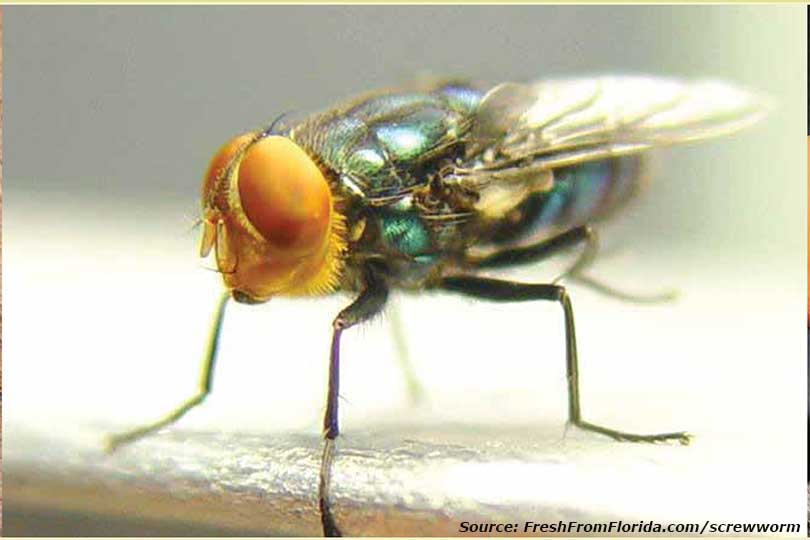By Shala Watson
Staff Writer
The first local infestation of New World screwworm in the U.S. in more than 30 years was confirmed in Florida last month.
The New World screwworms are fly larvae (maggots) that can infest livestock and other warm-blooded animals. They often enter an animal through an open wound and feed on the animal’s living flesh.
“We did a good job of getting rid of it many years ago, and the reason why is because it is such a nasty pest,” Dr. Sonja Swiger, Texas A&M AgriLife Extension Service veterinary entomologist at Stephenville, said in an interview with the Texas Farm Bureau Radio Network.
Swiger said Texas and Florida were the last two states to become fully eradicated from the parasite.
Initially, officials said the case was isolated to deer from a wildlife refuge in Big Pine Key and No Name Key Florida. But the screwworm has also been found in six areas west of Big Pine and No Name keys since then.
With efforts underway to quarantine and stop the spread of the outbreak, the number of deer killed continues to rise. Wildlife managers have confirmed the parasitic larvae have killed 114 endangered Key deer as of Tuesday, Oct. 25, according to the Miami Herald.
The rutting season in the Key area that began in August appears to be when the signs of the outbreak began.
“There’s reason to be concerned,” Dan Clark, head of the Florida Keys National Wildlife Refuges Complex, told the Miami Herald. “But the caveat is we’re still at the height of the rut. What I’m hoping is when the rut tapers off in December, there’s fewer wounds out there.”
Currently, most cases they’ve seen are in bucks. But if they don’t get the outbreak under control before spring fawning, it could spread to does and newborn fawns, Clark said.
Though there have been no human or livestock cases, experts warn the screwworm could lead to potentially devastating losses to wildlife, livestock and domestic pets.
Adult female flies are attracted to open wounds from procedures like dehorning and castration. They can also be drawn to newborn calves that have an exposed naval.
Swiger said they used to restrict the calving period to winter, so calves would not get attacked by the flies.
She also stressed the importance of knowing how to identify the screwworm. The maggots can look similar to blow flies that can infest matted areas in animals, but the screwworm has a distinct odor.
“There is a nasty smell that is associated with [screwworms] that is quite obvious,” Swiger said.
She said if you notice a unique smell that you might not be familiar with, it might be worth giving an extra look on that animal.
The pest was given the name New World screwworm because the one discovered in the Americas was a different species than the one found in Africa, which was referred to as the Old World screwworm, according to Swiger.
Animal health and wildlife officials have released sterile flies as part of their response efforts to prevent the infestation from spreading to new areas. The U.S. Department of Agriculture used this technique to eradicate the screwworm from the U.S. more than 30 years ago.
When the sterile male flies mate with local females, no offspring result. Female flies only mate once in their lifetime, so the fly breeds itself out of existence. But it may take six months to contain the infestation.
The cases reported since the screwworm was eradicated have been from people who traveled out of the country with pets to areas of South America where they still have it, according to Swiger.
Another method Florida officials are using to contain the outbreak is setting up an Animal Health Checkpoint for all motorists leaving the Florida Keys. Motorists are required to stop if they have any pets or livestock onboard to be inspected by Florida Department of Agriculture for signs of screwworm in all animals moving north from Mile Marker 91 to Mile Marker 106, according to the Florida Department of Agriculture and Consumer Sciences. As of Tuesday, Oct. 25, 883 animals have been checked, and none have tested positive for screwworms.
Additional efforts to stop the spread include a team of biologists and volunteers at the National Key Deer Refuge who are feeding the deer bread medicated with a potent anti-parasitic drug, doramectin, to help pr


I think this fly has spread to Iuka, Ms. I have some 2 week old puppies and I came from work today 8-29-19, found one of my puppies crying so to speak and weak. I picked it up to check it and bit had maggots infested in its butt area. It is dieing. I can not afford to take it to the vet. However reading article on the screwworm makes me beleive this is what has happened to my puppy. I know the difference between worms and maggots. These are maggots feeding on live flesh.